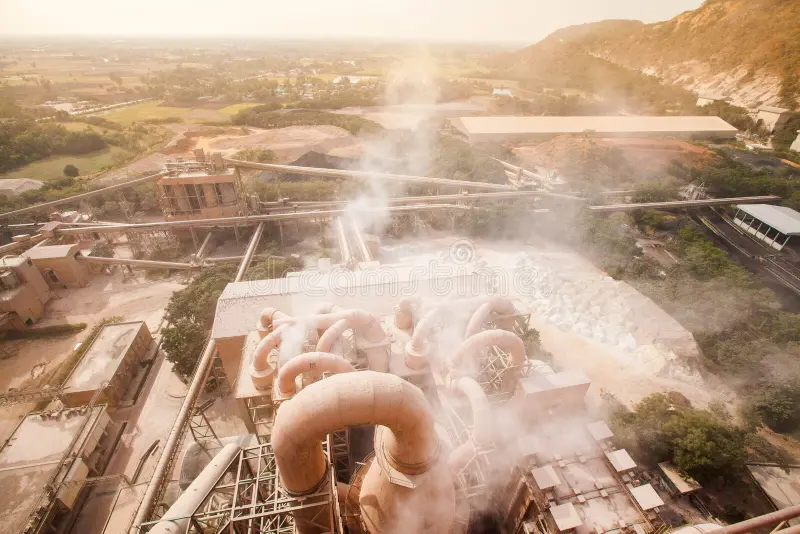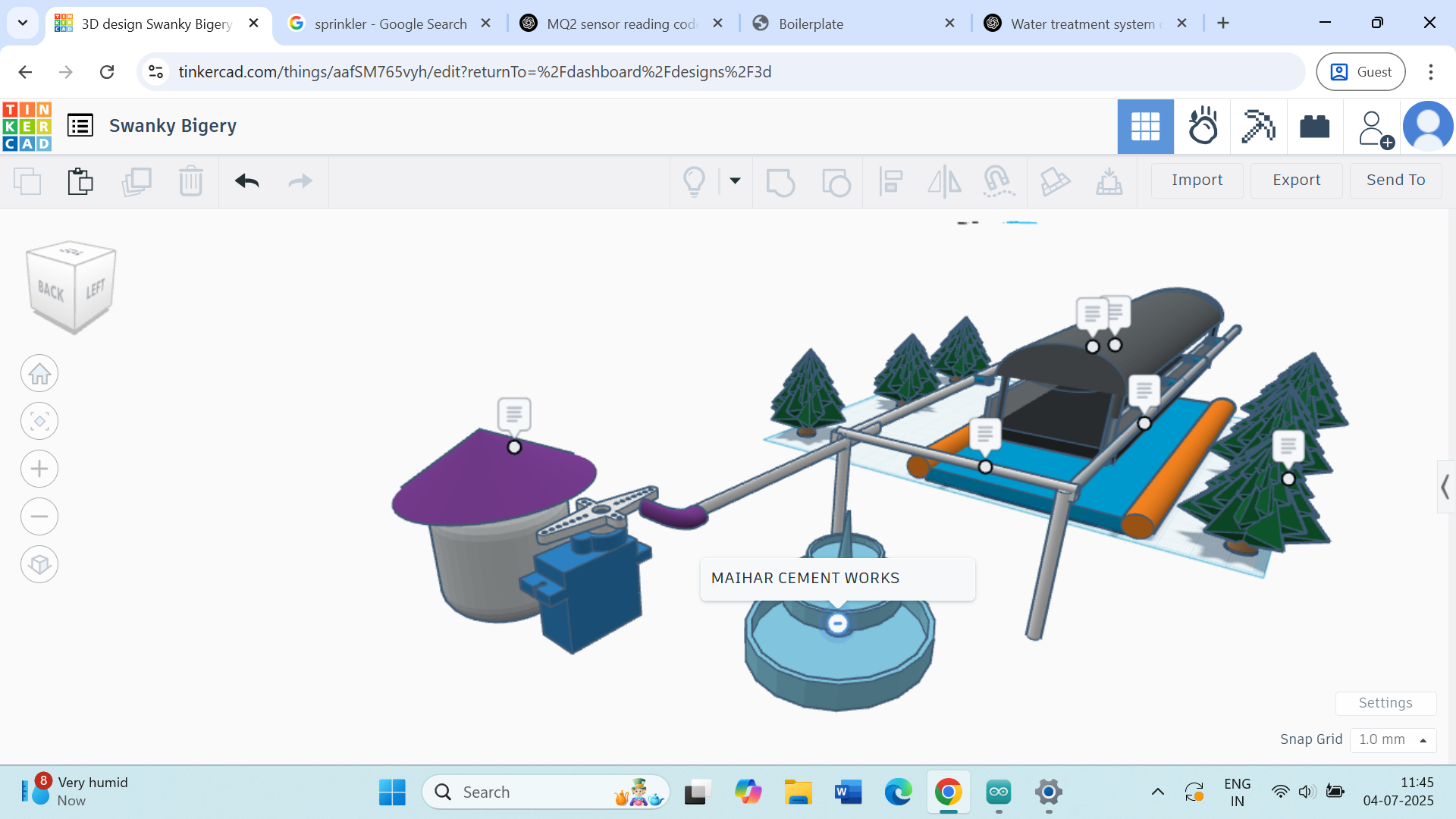The people living near by the factory are facing this problem and I'm also facing these problems and the problems are the dust released while production of cement , there is a lot of dust particles which are visible at the night and that also affects the garden and the vegetables which are planted near by the factory are covered with the dust particles .
We will solve the problem by : -We should plant trees and thick vegetation around its perimeter to act as a natural dust barrier.
Sarla nagar, Maihar, Madhya Pradesh, India
Solution
| Component | Description |
|---|---|
| Technical Components | ### Technical Components Needed 1. **Tin Shed Covering**: - **Material**: Galvanized steel or aluminum sheets for durability and resistance to corrosion. - **Usage**: To cover the conveyor belt and prevent dust particles from contaminating the water. 2. **Water Pipes and Sprinklers**: - **Pipes**: PVC or HDPE pipes (4 pipes, length as per conveyor belt dimensions). - **Sprinklers**: Low-pressure, high-efficiency sprinkler heads (spaced every 5 meters). - **Usage**: To distribute waste water evenly over the conveyor belt for dust suppression. 3. **Sewer System**: - **Material**: Concrete or PVC channels with grates to collect and channel the used water. - **Usage**: To collect the waste water from the conveyor belt area and direct it to the treatment system. 4. **Water Treatment System**: - **Components**: Sedimentation tank, filtration unit (sand or activated carbon), and disinfection unit (UV or chlorine). - **Usage**: To purify the collected waste water for reuse in irrigation. 5. **Pumps and Valves**: - **Components**: Centrifugal pumps for water circulation, control valves to regulate flow. - **Usage**: To ensure proper water pressure and flow in the sprinkler system and treatment process. 6. **Leak Detection and Control System**: - **Components**: Pressure sensors, flow meters, and automated shut-off valves. - **Usage**: To prevent leaks and excessive water usage. ### Recommended Tech Stack 1. **Materials**: - **Pipes and Fittings**: PVC or HDPE for corrosion resistance and durability. - **Sprinklers**: High-efficiency, low-pressure models to minimize water usage. - **Covering**: Galvanized steel or aluminum sheets for longevity. 2. **Water Treatment**: - **Filtration**: Sand filters or activated carbon filters for removing particulates. - **Disinfection**: UV treatment or chlorination to kill pathogens. 3. **Control Systems**: - **Sensors**: Pressure and flow sensors to monitor system performance. - **Automation**: Programmable Logic Controllers (PLCs) to automate water flow and leak detection. ### Detailed Implementation Steps 1. **Cover the Conveyor Belt**: - Erect a tin shed over the conveyor belt to prevent dust from contaminating the water. 2. **Install Pipes and Sprinklers**: - Lay 4 pipes around the conveyor belt, spaced appropriately. - Install sprinklers every 5 meters on the pipes. - Connect the pipes to a waste water source. 3. **Construct Sewer System**: - Build a sewer channel below the conveyor belt to collect used water. - Ensure the channel is sloped to direct water to the treatment system. 4. **Set Up Water Treatment**: - Install a sedimentation tank to remove large particles. - Add a filtration unit (sand or activated carbon) to remove finer particles. - Include a disinfection unit (UV or chlorine) to kill pathogens. 5. **Integrate Pumps and Valves**: - Install pumps to maintain water pressure in the sprinkler system. - Use control valves to regulate water flow and prevent overuse. 6. **Implement Leak Detection**: - Install pressure and flow sensors to monitor the system. - Connect sensors to automated shut-off valves to prevent leaks. 7. **Reuse Treated Water**: - Pump treated water to an irrigation system for plant watering. ### Required Technical Learning 1. **Water Treatment Processes**: - Learn about sedimentation, filtration, and disinfection techniques. 2. **Plumbing and Piping**: - Understand pipe sizing, pressure requirements, and sprinkler installation. 3. **Automation and Control**: - Learn about PLC programming and sensor integration for leak detection. 4. **Material Selection**: - Study the properties of materials like PVC, HDPE, and galvanized steel for durability and cost-effectiveness. ### Budget Calculation #### Hardware Costs 1. **Tin Shed Covering**: - Material: $5,000 (galvanized steel sheets, supports, and labor). - Installation: $2,000. 2. **Pipes and Sprinklers**: - Pipes (PVC/HDPE): $2,000 (for 4 pipes, length as per conveyor belt). - Sprinklers: $1,500 (high-efficiency, low-pressure models). - Fittings and Valves: $500. 3. **Sewer System**: - Concrete/PVC channels: $3,000 (including labor). - Grates: $500. 4. **Water Treatment System**: - Sedimentation tank: $2,000. - Filtration unit: $3,000. - Disinfection unit: $1,500 (UV or chlorine). 5. **Pumps and Valves**: - Centrifugal pumps: $1,000. - Control valves: $500. 6. **Leak Detection System**: - Sensors: $1,000 (pressure and flow sensors). - Automated shut-off valves: $500. - PLC: $1,000. **Total Hardware Costs**: $25,000. #### Software Costs 1. **PLC Programming**: - Software licenses: $500. - Integration and setup: $1,000. **Total Software Costs**: $1,500. #### Maintenance Costs (First Year) 1. **Routine Maintenance**: - Filter replacements: $500. - System checks and repairs: $1,000. 2. **Water Treatment Chemicals**: - Chlorine or UV lamp replacement: $500. **Total Maintenance Costs (First Year)**: $2,000. #### Total Estimated Budget - **Hardware**: $25,000. - **Software**: $1,500. - **Maintenance (First Year)**: $2,000. - **Total**: $28,500. |
| Key Features |
Feature: water sprinkling
Format: sprinkler Usage: to connect it with the water pipe (source)
Feature: Covering the conveyor belt
Format: coverage Usage: that will be used to stop the dust particles treating the water
Feature: purifying
Format: purifying Usage: that water will be reused to irrigate the plants |
| Implementation Steps | 1. Firstly we will cover the conveyor belt with tin shed . 2. We will put 4 pipes around the conveyor belt with sprinklers. 3. The sprinklers should be connected to the pipe after every 5 meters . 4. The waste water should be used in it . 5. Then we will form a sewer below the conveyor belt along the the conveyor belt . 6. Then we will treat that water and use it for the irrigation of the plants . |

